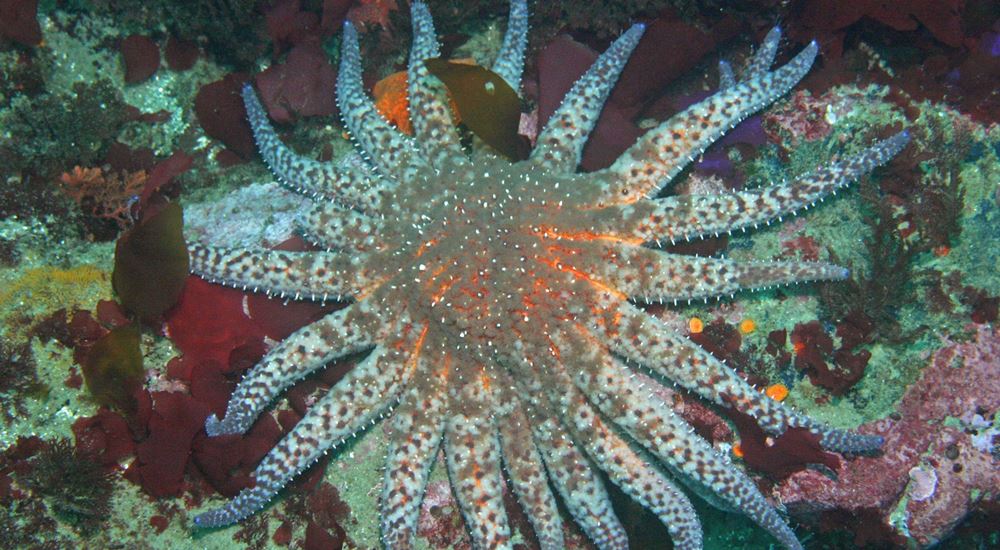A new study from the University of Oregon, Oregon State University, The Nature Conservancy and partner institutions provides the first experimental evidence that restoring the sunflower sea star (Pycnopodia helianthoides) is crucial to restoring the health and resilience of kelp forests along the Pacific Coast of North America.
This is important not just ecologically, but for the human coastal communities: kelp forests help protect the coast by absorbing wave energy, so the loss of these sea stars can lead to the loss of homes as coastal cliffs collapse.
Sunflower sea stars were observed in lab experiments to consume kelp-eating urchins at rates sufficient to both reset and maintain kelp forests.
This important discovery comes at a time when overabundant purple urchins have decimated whole forests of kelp along much of the Pacific Coast. The study calls for active management and a coordinated sunflower sea star recovery effort as key tools in kelp forest restoration.
Once abundant throughout their range in marine waters from Alaska, USA to Baja California, Mexico, sunflower sea stars experienced a severe population crash after the 2013 outbreak of the marine wildlife epidemic known as sea star wasting disease.
There has been little recovery since. This crash was followed by explosions of kelp-eating purple urchin (Strongylocentrotus purpuratus) populations in many parts of the West Coast. This overabundance of urchins, coupled with marine heat waves, is linked to a significant decline in kelp forests in many regions over the last several years.
Sunflower sea stars, listed as Critically Endangered by the International Union for the Conservation of Nature (IUCN), are generally thought to play a role in supporting healthy kelp forests via predation of kelp-eating purple urchins, but this important relationship has never before been quantified.
“Until now, there have been no published studies testing the predation rates of sunflower sea stars on purple sea urchins, and thus no way to reasonably estimate the impacts of sunflower sea star predation on purple urchin populations,” said Aaron Galloway, associate professor at the University of Oregon Institute of Marine Biology and principal investigator of the study.
“This study addresses that gap, and the findings are significant and somewhat surprising. We found that these stars are eager consumers of purple urchins and, most importantly, they even eat the nutritionally poor, starving, ‘zombie’ urchins,” Dr. Galloway continued.
Other important predators of purple sea urchins, such as sea otters, are generally known to avoid eating starving urchins from barrens—massive underwater carpets of urchins that have devoured their food supply and can persist in an emaciated state until new kelp grows.
The new study documents that sunflower sea stars eat about 0.68 sea urchins per day in the lab and that they eat starved urchins typical of barrens 21% faster than the well-fed urchins typical of kelp forests.
“Eating less than one urchin per day may not sound like a lot, but we think there used to be more than 5 billion sunflower sea stars,” said Dr. Sarah Gravem, a researcher at Oregon State University and co-lead author.
She continued, “We used a model to show that the pre-disease densities of sea stars on the US west coast were usually more than enough to keep sea urchin numbers down and prevent barrens.”
This finding suggests a clear link between the crash of sea stars, the explosion in sea urchin populations and the decline in kelp. It also points to sea star recovery as a potential key tool for kelp forest recovery.
The modeling expert on the study, Dr. Dan Okamoto of Florida State University, was surprised with how strong the results were, so he pushed the model further.
“Even when we assumed the stars eat fewer urchins than we measured in the lab and explored various predation scenarios, we found that sunflower sea stars could keep sea urchin populations in check and support healthy kelp forests. Our task now is to test whether these results hold in the wild. No model is perfect, but even when we were cautious, the results still indicated that sunflower sea stars play a critical role in keeping urchin populations in check,” he stated.
Because natural sunflower sea star recovery may not happen in the near term across much of the Pacific Coast without intervention, The Nature Conservancy and partners developed a Roadmap to Species Recovery.
“Species recovery is mission critical,” said Vienna Saccomanno, ocean scientist at The Nature Conservancy and a co-author of the study.
“It is time to take swift and decisive action toward recovering this iconic species to preserve biodiversity and further kelp forest restoration. And with more than 90% of the global population decimated by disease, there is no time to waste,” she concluded.
As a key element of this plan, The Nature Conservancy in partnership with the University of Washington and others is spearheading the world’s first captive breeding of the species and a pathway to re-introduction if that is deemed necessary and appropriate.
Photo of sunflower sea star courtesy of Steve Lonhart / NOAA.

